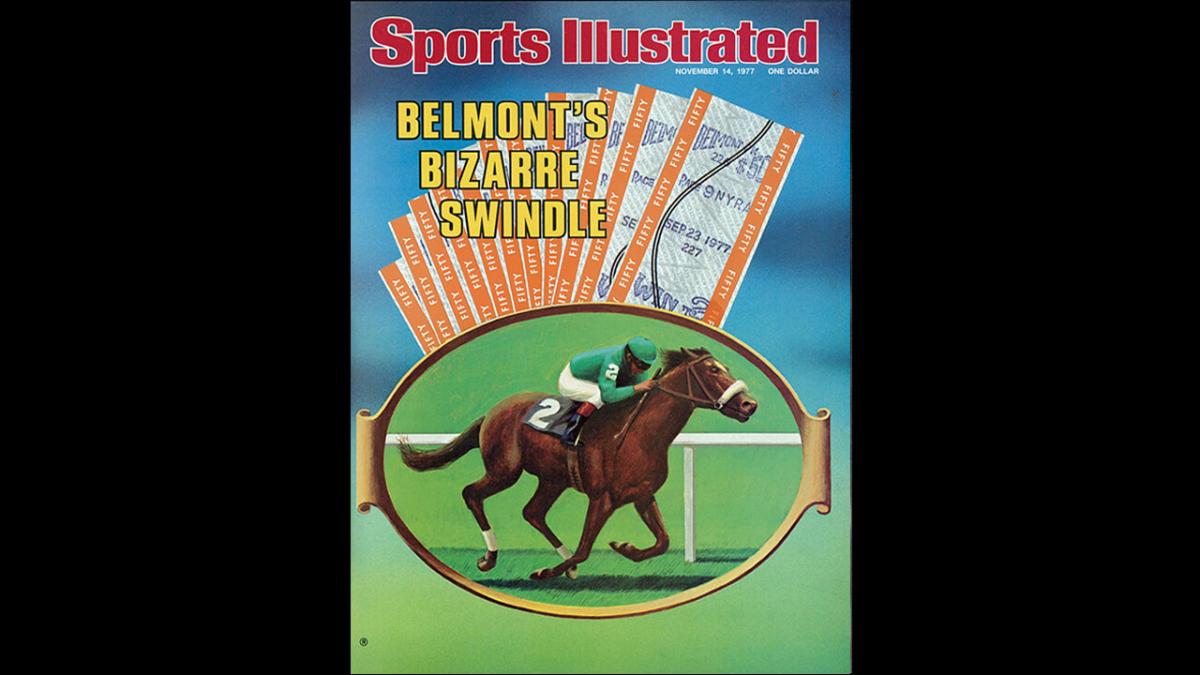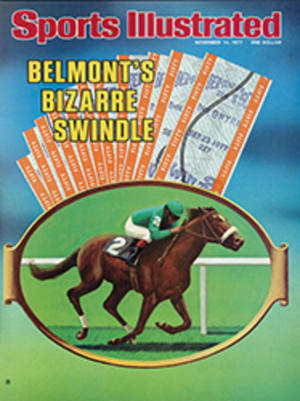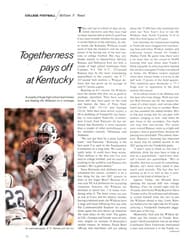
IS THIS HORSE THAT HORSE?
Now listen very carefully. This is the story of two racehorses from Uruguay, one the best inthat nation's history, the other a $600 castoff. It is the tale of a veterinarian who tends thoroughbreds as illustrious as Secretariat, of an elegant blonde shopping for a saddle horse in Montevideo, of a jockey not famed for his virtue bringing home a 57-to-1 shot at Belmont Park, of workouts in the dark of night, of a dead horse in a town dump, of a $10,000 bet that went wrong and a $1,300 bet that went right. It is the case of a ringer at America's most famous racecourse and a $150,000 insurance fraud.
Nothing like this has ever happened at any of New York's celebrated tracks—Aqueduct, Belmont Park and Saratoga—which draw five million people a year and $1.1 billion in bets on America's champions. Or has it? There have been shady cases "out of town" at tracks like Florida Downs and Hazel Park and at those nasty places up in New England that seem to court trouble. But the aristocratic Establishment of the sport never suspected the same sort of shenanigans could happen on its own turf.
To set the scene: it is Sept. 23, 1977, the last race on a murky Friday afternoon at Belmont. Rain is falling as a field of 12 sweeps into the final turn. Lebón, the long shot at 57 to 1, is leading easily by two lengths, his neck arched with the pride of a chess knight. Through the stretch Lebón increases his lead and wins by four lengths without being menaced. When the lights flash on the infield tote board, they show a $2 win bet on Lebón is worth $116, the biggest payoff in New York in months.
As always when along shot wins, bettors in the stands reexamine their Racing Forms to see whatthey missed in the horse's past performances. The Form shows Lebón is from Uruguay, that he has not won in 10 months, that he finished 11th of 12 starters two weeks before at Belmont in his first race in the U.S. A single mediocre workout is listed. His earnings for 1976 total $711. His races in Uruguay were sprints on the dirt. His Belmont upset has been accomplished on grass over 1¼ miles. Without inside information, a bet on Lebón at Belmont would have been stupid.
But at this moment Mark Gerard, a 43-year-old veterinarian, is stepping up to the $50 cashier's window in the Belmont clubhouse. He is recognized as he puts down $1,300 worth of win tickets and $600 worth of show tickets on Lebón. In the preceding half-hour Gerard had roamed back and forth from Window 226 in the grandstand, where $50 tickets are sold. His conduct was noticed, but he was not recognized. Gerard bought a handful of tickets on Lebón, went out to look atthe odds board, then returned for more. Now that his selection, No. 2, has come home in front, Gerard gathers up $80,440 in cash.
The Sept. 23 race—and its outcome—make more sense visualized another way, the way Belmont officials see it now. Forget Lebón and substitute in his place a horse called Cinzano. He, too, was bred and raced in Uruguay, but his form is brilliant. Cinzano ran eight times at Maronas, the Belmont Park of Montevideo, and won seven times. In his only defeat at that track he was bumped badly and injured, but still managed to finish second to Mogambo, one of the best runners in all of South America.
On his past form Cinzano would have run away with that Sept. 23 race at Belmont. He would have been the favorite, not a 57-to-1 shot. Because Cinzano is not Mr. Ed, the talking horse, it has taken more than a month to unravel the ringer case, which is what New York stewards say it is. They say the animal racing on Sept. 23 was not Lebón, that it could have been—in fact, almost certainly was—Cinzano.
The tipoff that something was amiss came with a phone call on Oct. 14 from a Uruguayan newspaperman to Bud Hyland, who serves as The Jockey Club steward in New York. Hyland was told Lebón could not have won the race, that the winner probably was Cinzano. The reporter gave no explanation as to how he knew this. There were rumors in New York last week that a blonde who allegedly plunged $10,000 on"Lebón" in his first U.S. start on Sept. 9, dropping the price on the horse from 55 to 1 to 7 to 1 at post time, was not told the horse would win his second start, and in her anger at being stiffed, alerted the Uruguayan newspaperman to the scam.
In any case, El Pais, a newspaper in Montevideo, asked the Associated Press for the winner's circle picture from the Sept. 23 race, and on the basis of that declared that Lebón was actually Cinzano.
By Oct. 25, the New York State Racing and Wagering Board was sufficiently convinced of hanky-panky to suspend the licenses of Gerard, who had imported Cinzano and Lebón, and 32-year-old Jack Morgan, who owned and trained the horse running as Lebón on Sept. 23.
How and when and why the horses were switched, if indeed they were, is still to be determined, though certain details are known. On the evening of June 3, 1977 Cinzano and Lebón were loaded on a turboprop plane in Carrasco, Uruguay. The aircraft, which also carried six Argentinian horses, continued to Tocumen Airport in Panama City to pick up another horse named Boots Colonero, who was also consigned to Gerard. In the case of Lebón and Cinzano, import papers show Dr.Gerard was acting as an agent in the purchase of the horses. Lebón was bought for $1,600 in Uruguay (after being sold at public auction shortly before for$600). Gerard sold him to Jack Morgan, who had served as one of his veterinary assistants for several years, for just under $10,000. Similarly, the Uruguayan owner of Cinzano received $81,000 for his horse, and Gerard turned him over to Tenafly, N.J. millionaire Joseph Taub for $150,000. Normally, an agent charges 10% commission, but Gerard had marked up Morgan's purchase 600% and Taub's 85%.
No identifying photographs accompanied the three horses on the flight, which arrived at 3:20p.m. June 4 at Kennedy Airport in New York. However, there were diagrams of their markings to help ascertain which animal was which. Lebón was listed as abay 5-year-old with a white star on his face and Cinzano a bay 4-year-old with a white star on his face and an easy-to-miss inch-long scar on his left shoulder. Cinzano's star, as El Pais was to note, was longer, lower and more irregular in shape than Lebón's.
The animals were met by Gerard, Eugene Hammer of Cardinal Air Services, which was handling the shipment, and a U.S. Department of Agriculture vet. Blood samples were taken to make sure the horses were not suffering from contagious diseases, and the horses were placed in a Lufthansa holding pen as they waited to be shipped to the USDA quarantine station in Clifton, N.J. Once there, the horses were isolated from other shipments and placed in quarantine until their blood samples were passed by the USDA lab, a procedure that normally takes from 48 to 72 hours.
There is often haste in unloading flights, and with nine horses aboard, this one was no different. Hammer says, "We move the animals quickly, and as the horses are led one by one down the ramp, vets say, O.K., this one's Jack Jones, and start taking down markings. Then as another horse follows, they may realize the second horse is Jack Jones, not the first. With two bay horses with stars, it could be that the names on their head collar plates were what caught the USDA vet's eye. That is a poor means of identification. En route, a groom may have to remove head collars to calm the horses and when he puts them back on, he can place them on the wrong horses."
Lebón and Cinzano were cleared by USDA chemists, and on June 11 were vanned to Gerard'sMuttontown, L.I. home. The next evening Cinzano is said to have suffered a fractured skull and broken ankle at Gerard's farm. Reportedly, Gerard learned of the accident while dining with friends, including horseman Frank Wright. Gerard left the dinner party and asked Wright to bring one of the guests back to his home if he did not return shortly. Wright did as he was asked and says that on arriving at Gerard's home he learned that the animal had been destroyed. He saw the body of a bay in the stable area.
At the time he was shipped to the U.S., Cinzano was insured for $150,000. The policy was written by the General Adjustment Bureau of Jericho, N.Y. on a London firm, and it was to the GAB that Gerard would have had to report, while the animal was still alive, that Cinzano had massive injuries.
When GAB representatives were queried about their handling of the Cinzano case last week, they were cautious. "We have an obligation to our customers not todiscuss this matter," said Manager Pete Lombardo. "We're not talking. We didn't do anything wrong."
Before insurance companies pay off on a claim, two veterinarians, one acting on behalf of the owner, the second for the insurer, must 1) certify that the horse is actually dead, 2) that the body resembles the insured horse and 3) that the cause of death is plausible—and this normally requires an autopsy. Did GAB have the signatures of two vets? "Right," said Lombardo. Could one vet call inanother, one he wanted to verify a death? "They're professional men,"said Lombardo. "They take the Hippocratic Oath, or something. We had no reason to be suspicious of Dr. Gerard. After all, he was the vet for Secretariat, wasn't he?"
Gerard signed an insurance claim on behalf of Taub (who was paid off in August). The second vet, whose name is on the document, is a longtime Gerard friend, Dr. Hap Hemphill. Hemphill is not talking.
In recent years Gerard has taken to wheeling and dealing in bloodstock, on the side, while increasing his veterinary practice. He has been importing thoroughbreds from South America, and there are horsemen who believe he has raced some of these under other people's names while retaining ownership. Many states forbid vets to own horses at tracks where they practice.
"I know Doc Gerard," says Jack Price, who owned and trained Carry Back. "I always got along with him fine. In reading about Lebón and Cinzano I get the feeling that he must be a Dr. Jekyll and Mr. Hyde. But I haven't been around him much in recent years. Certain things about this case make no sense whatsoever. Why would a vet with such a practice risk his career to pick up some money on a bet if he ran a ringer? Hell, a guy with his practice can make $250,000 a year just giving Butazolidin shots."
Gerard has drawn suspicion for a number of reasons. An elegant blonde who identified herself as Mrs. Gerard and who indeed resembled Alice Gerard (a tall, thin, stylish horsewoman of around 40) visited Uruguay and told Roberto Forné, who owned Cinzano, that she was buying Lebón to ride, not to race. The Uruguayans were suspicious about her shipping a cheap animal like Lebón such a long distance. It would seem a costly way to acquire a saddle horse. In the opinion of the South Americans, Lebón was finished as a racehorse, but his record (he won the first three starts of his career) might have appeared good enough to an American unfamiliar with Uruguayan racing—a Jack Morgan.
During September the Gerards appeared daily at Barn 59 at Belmont, where Lebón was stabled. A trainer whose horses are bedded down close by says, "I believed Gerard owned and was training the horse, though Morgan was the trainer of record. Since Saratoga I've been arriving at the track at 4:30 a.m.—the time most people come to work—and finding the Gerards already cooling out their horses. They were working them in the pitch black and were secretive."
Morgan's role in the affair is a mystery. He has admitted he won less than $2,000 on Lebón inthe Sept. 23 race, but said that he had never been suspicious that the animal Gerard sent to him was a ringer. Indeed, Morgan said he would take alie-detector test. It could be that he was an innocent. But before"Lebón's" first start, Morgan allegedly approached a vet working for another trainer and asked if he would check the horse's mouth to see if he could ascertain the animal's age. The vet declined to inspect the horse, knowing Gerard was caring far him. One might have thought Morgan, who had experience as a vet's assistant, could check out the teeth himself. However, South American horses are born in the fall of the year, rather than in the spring—so Morgan might have been confused. Why he did not ask Gerard, who was on the scene daily, is another matter. Was he suspicious?
Racetrackers, a notoriously distrustful lot, are asking questions about other matters. For instance, was it significant that Larry Adams, a 41-year-old journeyman jockey who has a reputation for riding long shots and who not long ago was reinstated after a lengthy suspension related to drugs, rode "Lebón"?
Then there is the mystery blonde who is said to have bet the bundle on "Lebón's" first Belmont start. Is she Christa Mancusa, a 5'2", 40-year-old, blue-eyed German who for years has raced horses in New York and Florida? Two of the men whom Dr. Gerard hired to train animals for Mancusa never met the woman, though she sent them monthly checks.
Who performed the autopsy on the bay horse said to be Cinzano and why was he removed from the Muttontown premises by Anthony Minieri of Dix Hills, N.Y. and—after Minieri had paid a $5 fee—thrown into the Huntington town dump? The dump register shows a 7-year-old bay (not a 4-year-old, as Cinzano was), with head injuries, being brought in. Dump officials say 60,000 tons of garbage now rest on the head of the bay with the fractured skull.
To try to make some sense of the swindle and find out if Cinzano is indeed the ringer, Joseph Mayer of the New York State Racing and Wagering Board, two New York vets, the registrar of The Jockey Club and a detective traveled to Uruguay last weekend to take blood samples of the relatives of the horses involved and question the South American principals. But to make a case against Gerard, authorities will have to produce evidence that he or agents acting with his consent knowingly switched horses or that he made false statements in order to collect the insurance on Cinzano.
Another necessity would seem to be to establish a foolproof method of registering horses entering the U.S. As things now stand, one could import a mule as a thoroughbred and it might go unnoticed. Unfortunately, The Jockey Club believes honorable people do honorable things and that most people in racing are honest. But the game has changed—as the Cinzano/ Lebón affair has demonstrated all too well.

